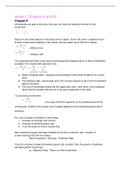Samenvatting
Summary Equity Risk
- Vak
- Instelling
Equity risk, also known as stock market risk, refers to the potential for financial loss due to fluctuations in the value of a company's stock. This type of risk is inherent in equity investment and is influenced by various factors such as market volatility, economic conditions, company performance...
[Meer zien]





